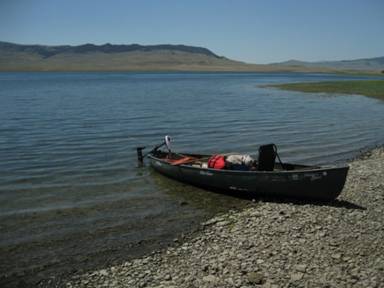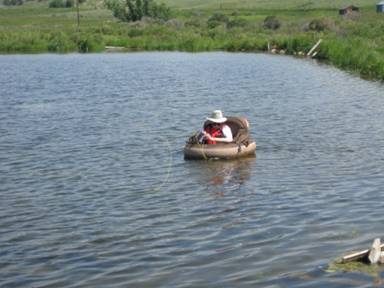FLOATING OPTIONS FOR FISHING STILLWATERS
When choosing a floating craft to fish on stillwaters there are a variety of things to be considered. One of the things that I have found to be of paramount importance is portability. Access too many stillwaters, particularly small ponds and mountain lakes, cannot be accomplished by motorized vehicles so if the angler wishes to use some type of water craft it may be necessary to carry or drag it to the water.
Anglers that fish running water in streams use a variety of means of accessing the water. In the West the boat of choice on many waters is the McKenzie boat, now commonly simply called a drift boat. These boats were originally used to float white-water on coastal rivers of the west coast where their flared sides and rocker-shaped bottoms allowed experienced operators to safely float water that had been previous off-limits or restricted to large rubber rafts. McKenzie type boats are now found coast to coast and even on rivers in other countries. While it is possible to use these types of boats on stillwaters they lack portability, which limits their use to places where you can drive and that have places to launch them. Even on waters where you can launch them anglers fishing from the higher platform of the McKenzie boat are more visible to fish in stillwaters, especially in shallow water or when the fish are feeding on the surface.
For the stillwater angler there are many alternatives that are better suited for fishing on stillwaters. Most of these alternatives provide a better fishing platform than the larger McKenzie boat, and they are considerable less expensive. In addition, most of these alternatives are more easily portable and allow the angler to access more and different waters than can be easily accessed with the larger McKenzie boat.

My canoe ready for a day on the lake
For the angler that prefers a rigid type vessel the canoe is a good choice. I have two canoes, an 18 foot aluminum model and a 13 foot polyethylene square stern model. The aluminum model is an old canoe that I have had for over 40 years, and the square stern model is a canoe that I purchased after my late wife had her left leg amputated due to cancer. Equipped with a small electric trolling motor it allowed us to continue to enjoy canoeing and fishing on our favorite stillwaters.

The Ladyfisher in a float tube
Back in the early 70’s I was introduced to the ‘belly boat’ or ‘float tube’ as it is commonly called today. Over the years I have owned a variety of these crafts from my first one, which was a simple gray vinyl cover that went over a truck inner tube. Except for a couple pockets that were stitched on the cover it was a no-frills model. With a pair of seal-dry waders and a pair of floating fins I chased gulpers on Hebgen Lake outside of West Yellowstone, and damselfly eaters on Henry’s Lake. I carried that tube into a variety of small lakes and ponds across the mountains of Montana and Wyoming, catching trout in a variety of otherwise inaccessible places. My current float tube has a vinyl bladder rather than a truck tire inside, it has multiple pockets and a back rest, but basically it still is highly portable. Newer types of float tubes sometimes called U-boats because of their U-shaped design have some advantages over the conventional round float tube.
In the mid-90’s I added another tool to my stillwater arsenal, a pontoon boat. My particular model is called a Versa-Vessel™ made by a company called Outdoor Engineering in Utah. I have the Lake-River model which has rocker-shaped pontoons that allows me to use it on stillwaters and running water. I have really enjoyed using this boat and would recommend it to anyone looking for a pontoon boat for personal use. [You can see their various pontoon boats at www.mertechengineering.com/boats.htm]
A pontoon boat allows the angler to cover more water than is possible with a float tube. Equipped with a set of oars you can cover quite a large area and many of these boats will even accept a small electric motor that increases the range even more. These boats can also be directed with a set of fins but I have found that not very effective except in very limited situations. Light in weight they can be transported fairly easily but they are not as portable as a float tube.
There are other types of floating craft that can be used for fishing in stillwaters. The standard Jon Boat [Also called a John Boat] makes a suitable fishing platform for use on stillwaters. Propelled with oars or a small motor they allow the angler to cover larger bodies of water quickly and safely. It’s possible to load a Jon boat up with a couple anglers, all their gear and a couple float tubes and quickly get to the place where the fish are working. Then it’s simply a matter of anchoring the Jon boat, and launching the tubes. Beats kicking a float tube for a long distance.
Some anglers prefer a small boat called a Pram. I have been intrigued by these small boats but I have never actually used one. For more information on this type of boat you can check out this website: www.springcreekprams.com They have some neat looking prams ideally suited for the fly-fishers.
There is a number of floating crafts that fly fishers can utilize to get them off the beach and out into the water. Whatever craft you chose don’t forget to wear a PFD, take your camera, and get out there and have a good time.
